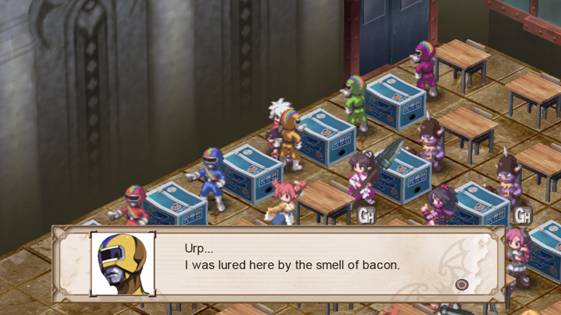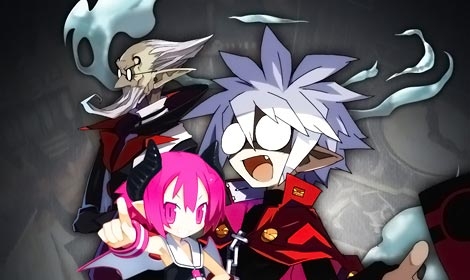It's back to the Netherworld and class is now in session for our favorite demons. You read that right, demons...in school. Apparently even demonic ne'er-do-wells have to go to school in order to learn their evil ways. It seems that a lot of recent RPGs have taken place in academia: Persona 3 and Mana Khemia: Alchemists of Al-Revis both have the protagonists battling their way through demons and monsters, all while attending classes.

Disgaea 3: Absence of Justice is the third incarnation of the popular strategy RPG from Nippon Ichi Software (NIS). Disgaea was the first big hit from NIS and has since enjoyed a huge cult following all over the world. The endearing Disgaea formula returns nearly unaltered, with the fan favorite Prinnies (explosive undead penguins) and characters classes (drawn by series veteran Takiheto Harada) making a comeback, retaining all the crazy moves and combinations seen in previous games. In this entry to the Disgaea universe you play as the number one honor student in Demon Academy, Mao. An unruly and rambunctious youth, Mao (imbued vocal life by American voice actor Vic Mignogna of Fullmetal Alchemist and Persona 3 fame) is the son of the Overlord, an authority whom Mao MUST kill simply because the evil daddy destroyed his video game system (yeah I know, seems to be a ridiculous reason to kill your father, but Mao is implacable). Mao's character is supposed to be a nerd and Mignogna really gives a great performance portraying it. On the other hand, the performance of the actor playing Mao (Hirata Hiromi) seems to be the same arrogant, hot headed tone and style as the one used for Laharl, the protagonist of the original Disgaea. On Mao's journey, he encounters many allies and enemies. The first ally you gain in the first two hours of the games is Almaz, a true hero and apparent rival to Mao, who is voiced by anime voice actor Johnny Yong Bosch (Vash in Trigun, and Ichigo in Bleach). Mr. Bosch's performance seems similar to the some of the roles he has portrayed in certain roles in the past: passive and uninteresting. I think that Bosch could have done a better job and shown more enthusiasm in his performance, like how he did Trigun.

Home room
Just like the previous Disgaea titles, you have the ability to gain new characters to help in future battles; however, due to the school atmosphere, instead of having a Dark Assembly, you now have a Homeroom class. In order to gain characters and different “world options” like being able to have cheaper or more expansive equipment at the item store, you need to earn mana. Mana is earned each time a final blow is delivered to your enemies. All of the things that you would have done at the Dark Assembly you do in the Homeroom. However, this time you have to "persuade" the class reps, by means of bribery or brute force, to do what you want. Dark Assembly and Homeroom are pretty much the same concept. There really isn’t anything NIS changed with this feature. The only significant new addition to this game was the "club" feature.
The "club" feature is a new concept allowing your characters more abilities. Depending on which club you join, your characters can gain certain support abilities. One such ability is the "magic change," which is possible if you have a monster fighter in a club with one of your humanoid fighters; you can use the magic change to transform the monster into a powerful weapon at your disposal. Unfortunately it can only be used for about two turns depending on your level. It is an interesting ability that has not been done in previous titles. "Magic change" gives your characters an extra boost in power, but they can only use their monster weapon for a certain number of turns. Clubs also affect character abilities based on where you sit in the classroom. For example, one of the clubs increases the amount of experience gained by 25 percent because the character is sitting in the corner of the classroom.

Battle System
The battle system in Disgaea 3 is similar to other turn-based, panel SRPGs. Like Final Fantasy Tactics and Fire Emblem, you have to take turns moving your characters around a map like a chess game; but unlike a chess game, your characters have the ability to lift up each other and throw them to different parts of the battle field, opening new strategy options. You also have many of the other abilities seen in any SRPG, like 'attack' and 'item use.' Disgaea is well immersed in different options for strategy. There are Geo Blocks, which are colored pyramid blocks seen in the original Disgaea. You use them to change the status effects and even color on the map. For example, if you have a Geo Block on a red panel which gives the enemy 50% more damage, enemies standing any red panels will gain a 50% boost - simple, right? There are many different types of Geo Blocks within the game that can either help or hinder your attack strategy. You can choose to use these block abilities or destroy them and fight enemies without the extra boost. These types of features during battle set Disgaea apart from other games in the genre. Having different options on attacking and strategy expands the gameplay, making it more absorbing.
Abilities
There are many abilities you can earn from the new “Evility” guy. Instead of leveling up your weapon’s ability and gaining new moves and magic, you have to go to the evil guy and use up your hard earned mana and buy new ones. This can be expensive, since most of the good abilities are in the four to five hundred mana range. It gives the player the opportunity to look and choose the abilities they want their character to gain (of course at the start of the game you can purchase the cheaper abilities that are about one to ten mana points each). It is a little frustrating, though, that you have to use mana in both the Homeroom and to gain new abilities. What they added not seen in the previous versions, is the ability to combine special abilities. For example, if one of your characters uses Blade Rush and another uses Spike Attack, you can execute the move at the same time to have the ability renamed to Blade Spike. These combination attacks appear very randomly, but once it happens, it’s pretty cool.
Graphics
Even though you are playing this game on the Playstation 3, it appears the system's power is hardly tapped and implemented. NIS decided to keep the original art style that was seen in the first two Disgaea games. The character sprites are slightly better looking and more refined this time around. The character animations are a little smoother and the game looks less jagged, which is welcome improvement over previous titles in the series. You still have the charming character designs from artist Takehito Harada, and some of his famous characters even make it back for a third appearance -- Pleinair, Adell, Rozalin, Etna, Evil Flonne, and Laharl are back to help or thwart Mao's plans to kill his father.
Even though the game doesn’t use the processing power of the Playstation 3 to its fullest, it makes up for it in the sound and dialogue. The writing in this game is hilarious. There are some really great jokes that makes the game more enjoyable and fun to play. The game makes fun of different anime and TV shows; references from shows like Dragon ball Z, Fist of the North Star and Mighty Morphin' Power Rangers are only a few of the great parodies contained within. The game itself is narrated like an anime. There are different chapters, and for each one there is a funny preview, which is hosted by many of the many characters.

Conclusion
Disgaea 3: Absence of Justice is a great third entry in the vaunted SRPG franchise. Fans will be able to pick up this game and will have no need for a tutorial. New gamers will have trouble figuring out what to do and understanding the many different elements of the game. It is hard sometimes to read the menus on a standard TV, but if you have an HDTV you shouldn’t have any problems. I found that NIS improved on the tutorial feature in this entry of the game. In previous games, the tutorial was very straight forward and a side mission while in the entry the tutorials are well integrated in the game. I think that NIS greatly improved on this feature of the game, Yet I found it disappointing that they got rid of some of the features that made the previous games Disgaea games all the fun, such as the ability gaining system. In the long run, gamers may find it frustrating that they will not have enough mana to get as much Homeroom abilities because of the need to keep up with improving characters abilities. As a result, players will now have to waste mana and go into even more training battles, which can make a long game even longer. Flaws aside, Disgaea 3: Absence of Justice is a pretty fun game. You will spend hours creating and improving characters and you will find it hard to put the controller down and stop grinding on enemies.

